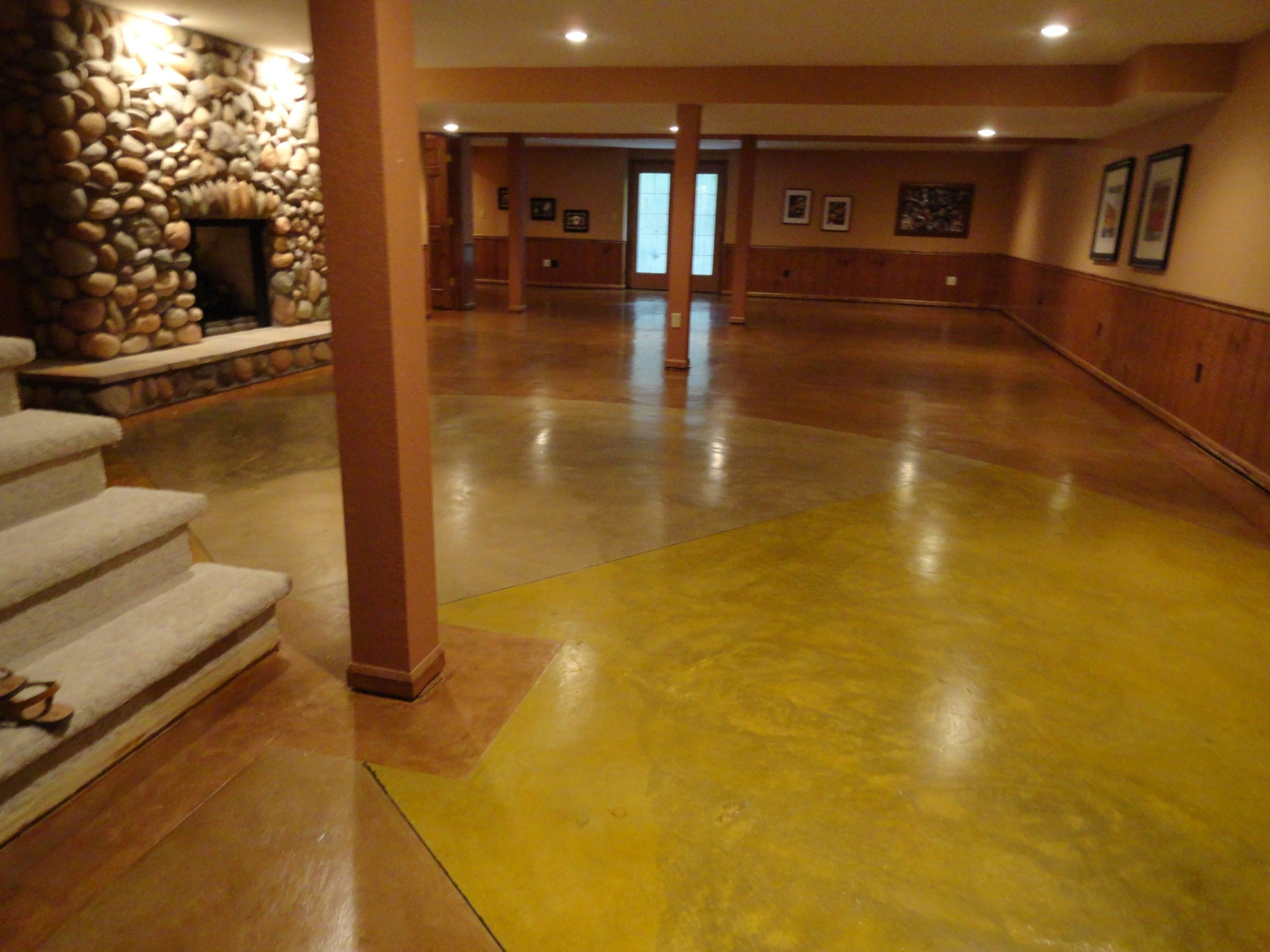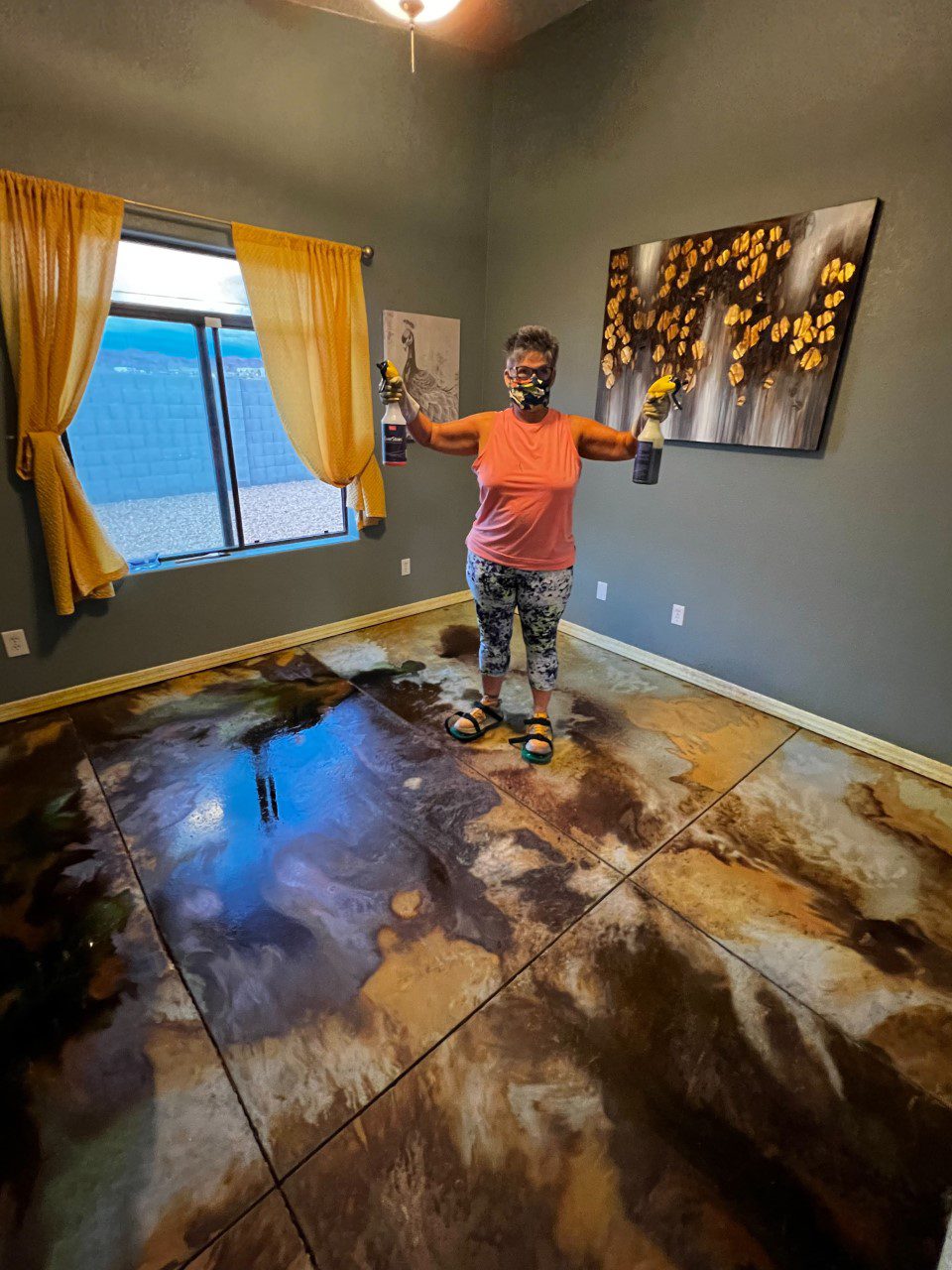Austin stained concrete company explains the difference between water-based stains
Recognizing the Series Of Solutions Offered in Floor Covering: Highlighting Stained Concrete Techniques
Stained concrete has emerged as an engaging floor covering option for numerous spaces. Its adaptability hinges on the selection between acid and water-based spots, each supplying distinct appearances. Proper prep work and recurring upkeep are vital to ensure its durability and look. As the need for ingenious flooring remedies grows, recognizing the subtleties of discolored concrete strategies might open up new possibilities for both property and commercial atmospheres. What unique benefits might this flooring option bring to a task?
The Basics of Stained Concrete
Stained concrete works as a versatile flooring choice that integrates durability with aesthetic charm. This floor covering technique involves applying a specially developed stain to the concrete surface area, which passes through and modifies the color of the material. The process not just enhances the appearances of concrete however also offers the advantage of protecting it from deterioration. Stained concrete can achieve a wide variety of looks, from earthy tones to lively colors, making it appropriate for numerous style motifs.
Appropriate prep work of the concrete surface area is vital for suitable results. This may include cleansing, grinding, or engraving to assure the stain adheres efficiently. Additionally, the application process normally includes making use of devices such as sprayers or brushes to accomplish consistent protection. After staining, a sealer is typically put on enhance longevity and keep the vibrancy of the shade. Inevitably, tarnished concrete supplies an eye-catching and long-lasting floor covering option for property and business spaces alike.
Sorts of Stains: Acid vs. Water-Based

In contrast, water-based stains provide a broader variety of shades and are easier to apply. They do not react chemically with concrete yet instead supply a surface area color - stained concrete. Water-based spots are low in unstable organic compounds (VOCs), making them a lot more eco pleasant and ideal for indoor tasks. While they might not give the same depth of shade as acid discolorations, their versatility and ease of use make them appealing for various applications. Ultimately, the choice depends on the project's requirements, desired aesthetic appeals, and place
Methods for Staining Concrete
The methods for staining concrete vary considerably between acid and water-based methods. Acid staining involves a chain reaction that creates distinct, variegated colors, while water-based discolorations supply a more comprehensive scheme and easier application. Understanding these procedures is crucial for accomplishing the wanted visual in concrete flooring.
Acid Staining Refine
Acid staining uses a dynamic way to boost the visual charm of concrete surfaces. This process involves applying a mix of water, hydrochloric acid, and pigments to the concrete, which reacts chemically to produce vivid, clear colors. The concrete surface area must be extensively cleaned up and prepped to guarantee excellent bond. Once used, the acid stain penetrates the concrete, developing distinct marbled results as it responds with the lime in the concrete. After the desired shade develops, the surface is neutralized and washed to halt the response. Finally, a sealant is put on secure the surface and boost toughness. Acid staining not just changes the appearance of concrete but additionally gives a resilient service for decorative floor covering.
Water-Based Staining Benefits
Exactly how can water-based staining boost the aesthetic and functional top qualities of concrete surfaces? Water-based spots offer a flexible remedy for enhancing concrete, supplying vibrant color alternatives while guaranteeing environmental safety and security. Unlike acid stains, water-based options pass through the surface, permitting also color distribution and a series of coatings, from matte to shiny. Additionally, they are low in unstable natural substances (VOCs), making them much less damaging to interior air high quality. Their quick drying time helps with quicker task conclusion, while their resistance to fading ensures resilient elegance. Water-based discolorations can also improve the concrete's durability and resistance to spots, making them an excellent selection for both residential and commercial applications. Ultimately, they offer a sustainable, appealing service for numerous concrete surface areas.
Layout Opportunities With Stained Concrete
Stained concrete deals a series of layout opportunities that can boost any space. Techniques such as color variation, various surface finishing options, and custom design patterns allow for special and personalized flooring remedies. These elements not only elevate appearances yet additionally add to the total capability of the concrete surface area.
Shade Variation Techniques
While checking out the layout possibilities of stained concrete, color variation methods play a pivotal function in enhancing both visual charm and functionality. These strategies enable the development of distinct patterns and impacts that can change a simple concrete surface area into a visually striking component of an area. Alternatives such as acid staining, which responds chemically with the concrete, create abundant, transparent colors that imitate all-natural rock. Water-based discolorations provide a broader shade combination and permit even more control in style. Layering various stains can develop depth and measurement, offering a personalized appearance. By integrating shade variation methods, developers can accomplish varied styles, from rustic to contemporary, ensuring that tarnished concrete fits effortlessly into any type of layout plan.
Surface Area Finishing Options
The exploration of shade variation methods establishes the stage for thinking about surface area finishing alternatives, which significantly affect the total appearance and functionality of discolored concrete. Numerous coatings can improve the visual appeal and toughness of the surface. Typical alternatives include matte, satin, and glossy surfaces, each giving a distinct visual impact. Matte coatings supply a subtle, understated sophistication, while satin coatings strike an equilibrium in between sheen and practicality, making them our website popular for domestic and industrial areas. Shiny coatings, on the various other hand, develop a high-shine look, enhancing color vibrancy and light representation. In image source addition, surface area therapies such as sprucing up or securing better boost long life, making these ending up alternatives important considerations in designing practical and visually appealing stained concrete floorings.
Personalized Layout Patterns
Just how can custom-made style patterns raise the charm of stained concrete? By incorporating unique layouts, tarnished concrete can transform common flooring into a striking visual statement. Custom patterns, such as geometric forms, detailed themes, or organic layouts, permit for personalization, making spaces really feel customized and inviting. Customers can pick from a range of techniques, including saw cuts, patterns, or overlays, to accomplish desired effects. Additionally, incorporating numerous colors with different stain techniques improves the deepness and measurement of the patterns. These style possibilities not just improve aesthetic allure however additionally boost the worth of domestic or commercial rooms. Eventually, custom layout patterns offer an opportunity for imagination, setting discolored concrete aside from traditional floor covering choices.
Preparing Your Concrete Surface Area
Appropriate prep work of the concrete surface is crucial for accomplishing an effective stained surface. This process begins with complete cleansing to remove dust, grease, and any type of various other contaminants. A stress washing machine or a flooring scrubber can successfully get rid of these materials, making sure a fresh start for staining. After cleaning, it is crucial to fix any fractures or blemishes in the concrete. This can be accomplished utilizing a concrete patching substance, which ought to be allowed to treat totally prior to proceeding.
When the surface area is tidy and fixed, grinding or sanding might be needed to create a smooth, also structure. This action boosts the concrete's ability to absorb the stain uniformly. A concrete etcher can be used to open up the pores of the surface area, allowing for better adhesion of the stain. By following these preparation steps, the resulting stained concrete will certainly display an extra vivid and lasting finish
Maintenance and Look After Stained Concrete
Maintaining tarnished concrete is important for protecting its appearance and longevity after the initial preparation and application of stain. Regular cleaning is very important; sweeping or vacuuming to eliminate dirt and debris prevents scrapes and monotony. For deeper cleaning, a light pH-neutral cleaning agent blended with water can be utilized, followed by complete rinsing to stay clear of residue buildup.
Sealing discolored concrete is an additional vital maintenance action, as it safeguards the surface area from spots and dampness. Relying on the sealer type, reapplication may be essential each to three years. Additionally, staying clear of extreme chemicals and abrasive devices assists maintain the honesty of the stain.
For outside stained concrete, it is advisable to clear snow or ice without delay to protect against damage from freeze-thaw cycles. Overall, constant treatment assurances that stained concrete preserves its dynamic color and architectural security over time, making it a long-lasting floor covering option.

Price Factors To Consider for Stained Concrete Floor Covering
When assessing the expense of discolored concrete flooring, prospective homeowners usually question the different factors that influence prices. Secret considerations include the size of the area to be covered, the intricacy of the style, and you can try this out the kind of stain utilized. Standard staining techniques often tend to be extra inexpensive, while intricate patterns or several shades can considerably increase prices.

Geographical area is another aspect, as prices can vary commonly from one area to one more. Lastly, continuous maintenance expenses ought to be factored in, as sealants and safety layers might be required in time to maintain the visual and resilience of the stained concrete.
Regularly Asked Concerns
Can Stained Concrete Be Applied Over Existing Flooring?
The question of whether tarnished concrete can be applied over existing flooring is often asked. Generally, it is possible, offered the underlying surface area is clean, secure, and appropriate for correct bond of the stained concrete.
How much time Does the Staining Process Take?
The staining procedure usually takes a couple of hours to a full day, relying on the size of the area and the intricacy of the design. Treating might require added time before the surface is totally usable.
Is Stained Concrete Suitable for Outdoor Use?
Stained concrete is without a doubt suitable for outside usage, as it withstands different weather. Its sturdiness and visual allure make it a popular option for patio areas, sidewalks, and driveways, enhancing both performance and aesthetic passion.
Can I Modification the Color of Stained Concrete Later On?
The ability to alter the shade of tarnished concrete later depends upon different variables, including the initial stain kind and surface prep work. Consulting an expert can provide support on possible alternatives and results for color modification.
Are There Eco-Friendly Options for Stained Concrete?
The questions concerning environmentally friendly choices for tarnished concrete discloses an expanding interest in lasting building practices. Numerous companies now offer low-VOC stains and environmentally friendly sealants, ensuring visual allure while decreasing ecological influence.